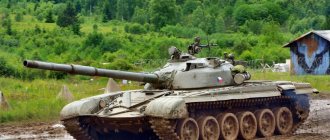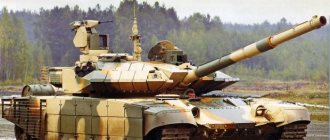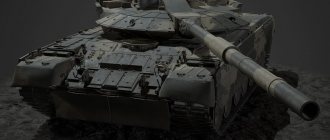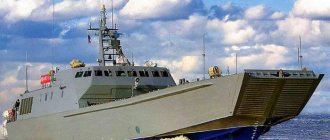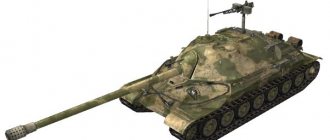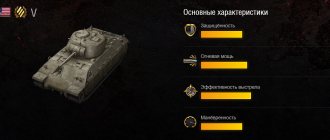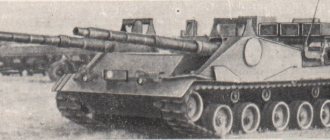Academician
04/13/2012, 10:19, , 426, Category Equipment
Top 10 heavy tanks in the world
Military tanks
, is an impressive sight. The tank was conceived as the main weapon against infantry.
Below, the TOP 10 largest tanks by weight and size in the world. Almost all super heavy tanks were built or developed during World War II.
Above, photos of the actually created gun, which was supposed to be installed on the Monster tank
Landkreuzer P. 1500 Monster
Germany, 1942, 42 meters, weight 1500 tons, crew 100 people
In 1942, Hitler approved the design and construction of the monster tank, but the project was canceled in 1943 before construction had even begun. The tank was supposed to be fifteen times larger than a regular tank, it was supposed to be equipped with an 800 mm Krupp gun (regular tanks are equipped with 75 - 122 mm guns).
The 800 mm Krupp gun is the largest artillery piece ever built. Each shell weighed 7 tons and had a firing range of up to 37 km (23 mi).
Landkreuzer P. 1000 Ratte
Landkreuzer P. 1000 Ratte
Germaniz, 1942, 35 meters, weight 1000 tons, crew 20 people
Ratte looked a lot like a monster. It was also developed in 1942 and was also discontinued a year later. Unlike the Monster, the Ratte was to be armed with a warship turret with two 280mm cannons. Other weapons on the Ratte include one 128 mm cannon, eight 20 mm anti-aircraft guns and several 15 mm machine guns.
VIII Mouse
Tank VIII Maus is the largest tank ever built. It is small compared to the Monster and Ratte, but is still three times larger than a regular tank. Design was completed in 1942 and production began the same year, but only two tanks were built before the end of the war.
The tanks were armed with one 128 mm gun and one 75 mm gun.
Tank VIII Mouse
Germany, 1944 - 10 meters, weight 188 tons, crew 6
E-100 Tiger Mouse
The super heavy tank is very similar to the VIII Mouse tank. This project was started in 1942, but not all tanks were built. One tank hull was built in 1944, but the turret was not installed until after the war.
The E-100 Tiger Mouse was to use the same turrets as the VIII Mouse tank. Thanks to its lighter weight, this tank should be faster and more effective on the battlefield than the VIII Mouse tank.
E-100 Tiger Mouse
Germany, 1943 - 10 meters, weight 140 tons, crew 5 people
FCM F1
FCM F1 is the heaviest and largest tank of non-Nazi origin. It was intended to replace the Char 2C, which was one of the heaviest tanks that had never been used in combat. Unfortunately, France was defeated before the FCM F1 project was completed, so none of these tanks were built.
The FCM F1 was supposed to be armed with a 90 mm cannon, a 47 mm cannon, and six machine guns. It's worth noting that this tank was 10 meters long, but only just over 3 meters wide, so it could have been transported by rail.
FCM F1
France, 1940, 11 meters, weight 139 tons, crew 9 people
OI
OI, this is Japan's attempt to create a super heavy tank. There are reports from various sources that one model was completed and sent to Manchuria during World War II, but this is highly unlikely and is more likely to be rumor than truth. OI was probably canceled like most other super heavy tank projects.
OI was to have three turrets. The main turret had a 105 mm cannon, the right turret had a 37 mm cannon, and the left turret had three machine guns.
OI
Japan, 1944, 10 meters, weight 130 tons, crew 11 people
K-Wagen
The K-Wagen was one of the first attempts to create a super-heavy tank. Again, it was a crazy plan by engineers from Germany, but this time it was before the Nazi era.
The K-Wagen did not have a main turret. Instead there were four side-mounted 77 mm guns and seven machine guns. It is the second largest tank ever actually built - only the VII Maus tank is larger, as all other super-heavy tank projects were not completed.
K-Wagen
Germany, 1917, 13 meters, weight 120 tons, crew 27 people
T-28
The T-28 was developed by the American military during World War II. It was to be used to break through German defenses and a possible invasion of Japan.
The T-28 did not have a normal turret, so it could be classified as a tank destroyer, self-propelled gun, and not a super heavy tank. For this reason, it was renamed from T-28 to T-95, and then back again.
It was armed with one 105 mm cannon and a single machine gun. It had 4 tracks instead of the traditional 2.
T-28
USA, 1945, 11 meters, weight 95 tons, crew 8 people
TOG2
TOG2 was the largest British tank ever built. Just like most other super-heavy tanks, it was developed during World War II. One prototype was built in 1941, but the project was shelved and TOG2 never saw combat.
TOG2 was armed with one 76 mm cannon.
TOG2
Great Britain, 1940, 10 meters, weight 80 tons, crew 8 people
A39 turtle
Another British super heavy tank. The tank was also developed during World War II, but was never put into production.
The A39 Turtle was armed with a 96 mm cannon and three machine guns.
A39 Turtle
Great Britain, 1944 - 10 meters, weight 78 tons, crew 7 people
Why did the army abandon heavy tanks?
Interestingly, almost all of the tanks in the top 10 were built during World War II. What made engineers try to build such monsters at this time, and why weren't such tanks built until now?
The main reason for creating a super-heavy tank was immunity from enemy fire. The super heavy tank had thick armor that would have been impenetrable to most WWII guns.
There are several reasons for abandoning these tanks:
— cumulative shells appeared. Which could penetrate armor up to 500 mm or even more;
- the tank could be hit with the help of aircraft;
— poor maneuverability of the tank during advance and retreat, which limited its use on the battlefield.
Another problem was the transportation of super-heavy tanks. Most were too large to be transported by rail, so they had to rely only on their own propulsion abilities. The problem is that most of them moved extremely slowly, so they could not reach the battlefield at the right time.
In addition, super-heavy tanks destroy roads. Therefore, they would have to drive over rough terrain, which would further slow down the movement.
Heavy tank IS-2 (video):
Heavy tank Grote R-1000 (video):
Heavy tanks IS-3, IS-7 (video):
Similar articles:
VT-4/MBT3000 (China)
For the last half century, Chinese-made tanks have not been considered very technical, especially when compared to American standards. Everything turned out this way because tank building as an industry had never been developed in the Celestial Empire, and tanks were designed and developed based on the example of what was seen or captured. As a result of these manipulations, a very similar tank was obtained, but technically it was much weaker than the original. The trends of past years pleasantly surprise the eye, although everyone knows that modern Chinese combat vehicles still use drawings of foreign designs in the old way, but there are some quite successful works. One of them is the VT-4 tank, which has a digitized interface and a clear fire control system, which with its characteristics increases the vehicle’s performance. The tank also has a tracking system for missile launchers and, if necessary, protection against them is activated.
Weight - 52 tons
Maximum speed - 70 km/h
Crew - 3 people
Engine power - 1300 hp.
German Leopard 2A7
This self-propelled vehicle is nothing more than a modernized Leopard 2 tank. Unlike its progenitor, this model has good power, a modern electronic system, improved protection and the ability to fight both within the city and beyond.
Increased aiming accuracy is achieved due to the installed advanced guns. Despite its heavy weight, the Leopard 2A7 is a fairly maneuverable vehicle.
So we looked at the best tanks in the world. The top 10 you just saw is still relevant today. Each of the presented tanks showed excellent results when performing combat missions.
BM "Oplot" (Ukraine)
The Kharkov plant, which was engaged in the production of T-80UD combat vehicles, after the collapse of the Soviet Union, stopped its work on this model... only to make its own version of this tank!
This is how the T-84 tank, an improved version of the T-80, which was later renamed the Oplot BM, saw the light of day. It has been improved and modernized so much that this model is considered one of the best on the market. The Oplot has a 125 mm smoothbore cannon that fires armor-piercing and explosive ammunition, as well as anti-tank missiles. The time it takes for the ammunition to be sent to the autoloader is 8 seconds; an improved ballistic computer helps the tank fire on the move, which makes it a real monster of technology. It may well compete with the Russian “Armata”, which at one time caused a lot of noise. Weight - 51 tons
Maximum
speed - 70 km/h
Crew - 3 people
Engine power - 1200 hp.
Russian T-90
This combat vehicle is equipped with a 125-mm smoothbore gun, which allows firing using armor-piercing sub-caliber, cumulative, high-explosive fragmentation shells and anti-tank missile systems. The roof of the turret is equipped with a 12.7 mm machine gun, the firing rate of which is from 700 to 800 rounds per minute. Thanks to this rate of fire, you can shoot at objects in the air. The PKT 3000 coaxial machine gun is used to fire at a distance of no more than 2 kilometers.
T-90AM (Russia)
This tank is often compared to its American counterpart, the Abrams, but according to experts, the American is still stronger. But the T-90 has nothing in common with American tank building; it is only a modernized model of the Soviet T-72 tank, which many countries still use in their combat arsenal. The T-90AM has improved characteristics compared to its predecessor: its turret can withstand an armor-piercing projectile, in addition, it has a missile search system and an anti-shock system. The main weapon is a 125 mm cannon.
Weight - 48 tons
Maximum
speed - 65 km/h
Crew - 3 people
Engine power - 1130 hp.
AMX-56 Leclerc (France)
This tank is one of the most expensive tanks in the world, due to the set of complex complexes and systems that are installed on board. Powerful thermal imagers and rangefinders can identify and target the enemy at a distance of 4 km. The fire will be conducted from a 120 mm smoothbore cannon, into which one shell can be placed every 5 seconds. The fire control system can select more than six targets and hit them within half a minute. The tank is protected by tungsten and titanium modules and active-reactive armor. There is also a missile warning system, a system against anti-personnel mines, and a laser system.
Weight - 57.4 tons
Maximum
speed - 71 km/h
Crew - 3 people
Engine power - 1500 hp.
Char 2C
This colossus was already of French production, and it became the largest tank put into mass production. It weighed 75 tons and, according to the designers’ plans, it should have easily broken through barrier lines on the front line. The tank's parameters were also very impressive:
- length 10.2 m;
- width 3 m;
- height 4 m.
But the tank turned out to be extremely clumsy, in addition, it destroyed an incredible amount of fuel (more than 1000 liters were required per 100 km). Therefore, in 1940 it was removed from service. The characteristics of the Char 2C were the crowning achievement of the development of the concept of a heavy tank capable of breaking through positional defenses, but this was typical for World War I. The big problem with these machines was their enormous mass, which made them very slow. In the case of trench warfare, for which this tank was designed, this was not a big problem, but in the early 1930s, military tactics began to change, where there was no longer room for stable front lines. The time had come for maneuver warfare, in which super-heavy tanks were useless. It was impossible to quickly transfer them to a new bridgehead, and tactical use required prepared logistics support.
Challenger 2 (UK)
High-quality Dorchester armor gave this tank cult status; it was rightfully considered one of the most protected tanks in the world. It is unknown what this armor is made of, but it is believed that it is an alloy of cermets and some unknown metals. This monster appeared on the world stage in 1998, during the war in Iraq, and its armor saved it more than once from enemy grenade launchers. During its entire existence, this tank was defeated only once, when by mistake the same vehicle fired its shell at it. The main weapon of the tank is a 120 mm rifled cannon, thanks to the guidance system, it accurately hits the target. A British computer system is responsible for controlling this colossus, and firing is carried out from a computer made in Canada
Weight - 62.5 tons
Maximum
speed - 56 km/h
Crew - 4 people
Engine power - 1200 hp.
"Tsar Tank"
Russia decided to create such a tank at the height of World War I - in 1915. They called it whatever they called it: loudly - “Tsar Tank”, “mastodon”, “mammoth”, or modestly - “Lebedenko’s machine”. The strength parameters on wheels are impressive:
- length 17.8 m;
- width 12 m;
- height 9 m;
- combat weight 60 tons.
Such a monster could be seen several kilometers away. The gun turret of this prototype rested on a carriage mounted on two huge wheels. The famous Russian engineers Stechkin and Mikulin had a hand in creating the drawings of this colossus. A minimum of 15 crew members had to service the tank. On a flat road it could travel at speeds of up to 17 km/h. Only one test copy of such a tank was produced, but it did not pass initial tests. This structure was difficult to use in tactical maneuver warfare; rather, it was a fortress on wheels. The discovered serious shortcomings put an end to the whole idea, primarily due to the huge dimensions of the machine. Therefore, the Tsar Tank never went into production, and its test copy faced an unenviable fate - in 1923 it was dismantled for scrap.
Top largest ships in the world Since ancient times, people have traveled the seas, gradually improving their ships. Modern shipbuilding is very developed, and the range of ships has become ...
Leopard 2A7+ (Germany)
This tank is rightfully considered a veteran; it was put into service back in 1979. Despite this, it is one of the best fighting vehicles on the world stage until today. This version of the tank absorbed all the most innovative developments and ideas formed after its predecessor went through many battles and battles during the military operations in Iraq. The Leopard 2 fires from a 120 mm smoothbore cannon, which is suitable for various types of ammunition, including LAHAT - a guided missile. The shot can be fired at a distance of 5 km. The latest sights allow this tank to feel like it is in charge on the battlefield when enemy vehicles come against it. The disadvantage of Leopard 2 is the lack of dynamic protection, but there is multi-layer composite armor, under which there is also modular profiled armor, which increases the protection several times.
Weight - 67 tons
Maximum
speed - 72 km/h
Crew - 4 people
Engine power - 1500 hp.
Ukrainian Oplot-M
This is the main combat vehicle in service with the Ukrainian army; it was developed by the Kharkov Mechanical Engineering Design Bureau, headed by Mikhail Demyanovich Borisyuk.
Oplot-M is an improved model of the T-84U tank. The combat vehicle was first presented to the public in 2009 on Ukraine’s Independence Day.
The tank is equipped with modern guns; only the automatic ammunition supply system was retained from the T-84 BM. Just like in China's combat development, the shells are located in the same compartment as the crew.
The Ukrainian tank does not cause significant damage to distant targets, but it overcomes anti-tank missile systems well.
Today, the Ukrainian armies are testing the combat vehicle, and the tank is planned to enter service in the near future. The power, security and ability to quickly change the direction of movement of the Ukrainian tank have practically no distinctive features from the latest versions of the T-90 BM, manufactured in Russia, although the production of new units is limited.
Type 10 (Japan)
Few people associate modern military equipment with Japan, but it was in Japan that this magnificent killing machine, the Type 10, was developed. It appeared on the combat arena in 2012.
The Land of the Rising Sun has outdone itself by developing this technically ingenious machine. The fire will be introduced from a 120 mm smoothbore gun, with an automatic loading system. The crew of the tank is three people. They are located in a part of the tank that is protected by nanocrystalline steel, this steel is three times stronger than regular steel. The tank is equipped with modern computers that monitor what is happening on the battlefield, which gives this tank a huge advantage over others. Weight - 44 tons
Maximum
speed - 70 km/h
Crew - 4 people
Engine power - 1200 hp.
Merkava IVm (Israel)
Israel has always purchased foreign tanks, but constant hostilities and the difficult situation in the country forced the government to develop its own unit - the Merkava tank. The crew of the tank is four people, besides them, the tank can fit a couple more soldiers. The basis of this tank is protection. It is protected by modular armor, which can be quickly replaced if necessary. The creators paid great attention to the elements of camouflage. Even the colors of the exhaust gases of this tank do not attract attention. The Trophy protection system warns the tank crew of impending danger and can also stop anti-tank missiles. The weapon on this tank is a 120 mm smoothbore gun.
Weight - 70 tons
Maximum
speed - 60 km/h
Crew - 4 people
Engine power - 1500 hp.
M1A2 SEPv2 (USA)
Of the many tanks, this tank has the most military experience. It has been used since 1980, but if you think that this model is already old and worthless, you are mistaken, it is constantly updated and modernized. The tank fires from a 120 mm smoothbore cannon, which is suitable for all types of shells, so this tank can hit any target and penetrate any armor. Protected by M1A2 SEPv2 laminated steel composite. To create this tank, they even use depleted uranium, which has a very high density and is practically impossible to penetrate. Also, this tank uses the latest technologies - the best thermal imagers and GPS navigation systems. We left the most interesting fact for dessert - the tank has a remote control.
Weight - 63.1 tons
Maximum
speed - 66.8 km/h
Crew - 4 people
Engine power - 1500 hp.
American M1A2 Abrams
In the United States of America, this combat vehicle is considered the main one. The first model appeared in 1980. These tanks are in service not only in the American army, but also in the armies of Egypt, Kuwait, Australia, Saudi Arabia and Iraq. The name of the combat vehicle is associated with the name of General Abrams Creighton.
American combat development has proven itself remarkably well in combat operations; it poses a real threat to enemy troops.
The Abrams is perfectly protected from various anti-tank weapons, as the armor is reinforced with uranium. There are newly invented guns on board. The self-propelled vehicle is equipped with a gas turbine engine of excellent performance, although it is difficult to maintain, and fuel costs are also high.
K2 Black Panther (South Korea)
In the mid-nineties, South Korea began developing its own tank. Hyundai has developed the K2 Black Panther. This tank is like a combination of the best technical solutions of all the tanks described above. Externally, it is similar to the German Leopard2, as well as partially in terms of filling. The Korean tank has a German smoothbore gun and an engine that runs on a diesel engine with a capacity of 1,500 horsepower. Loading shells is similar to loading shells on the French AMX-56 Leclerc. The firing rate of this tank is 10 shots in 60 seconds. Modern tracking systems allow the tank to feel confident on the battlefield. The Korean tank is protected by composite and explosive reactive armor. As elsewhere, there are two defense systems: passive - detects threats and creates interference, and active - can stop missiles, like the Israeli Merkava.
Weight - 55 tons
Maximum
speed - 70 km/h
Crew - 3 people
Engine power - 1500 hp.
